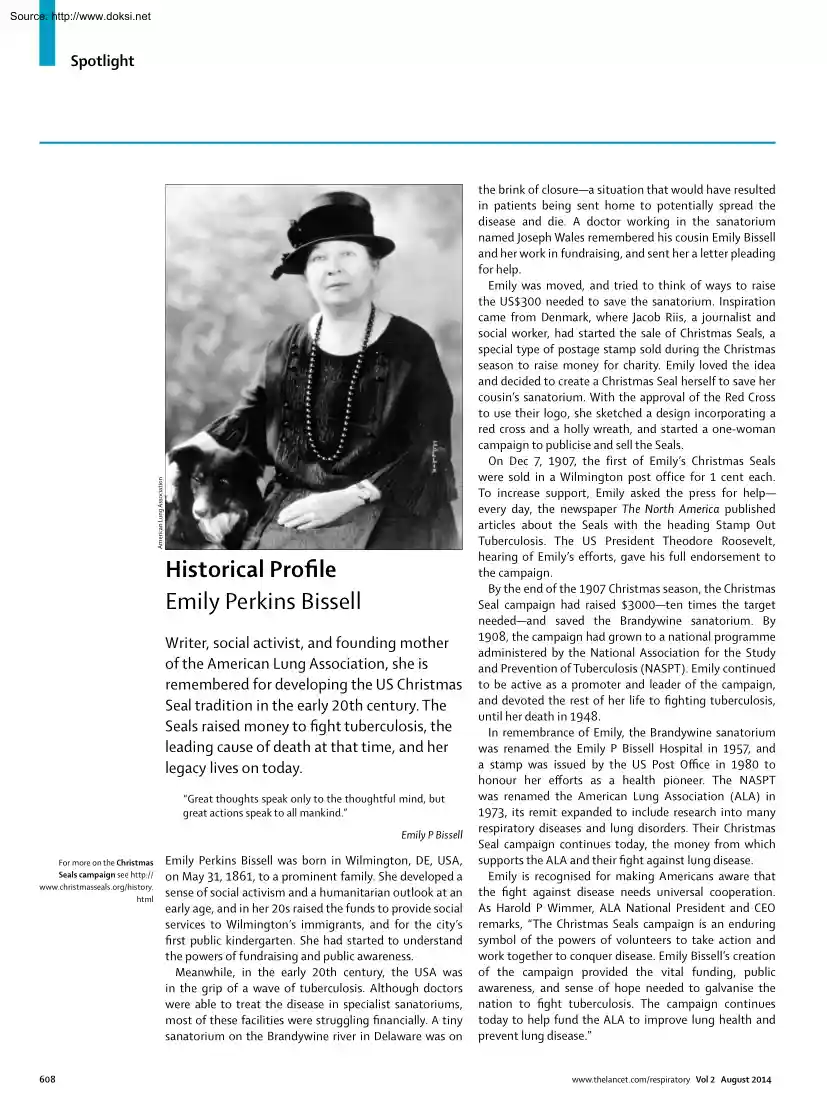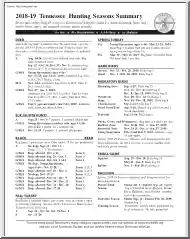Please log in to read this in our online viewer!

Please log in to read this in our online viewer!
No comments yet. You can be the first!
What did others read after this?
Content extract
Source: http://www.doksinet American Lung Association Spotlight Historical Profile Emily Perkins Bissell Writer, social activist, and founding mother of the American Lung Association, she is remembered for developing the US Christmas Seal tradition in the early 20th century. The Seals raised money to fight tuberculosis, the leading cause of death at that time, and her legacy lives on today. “Great thoughts speak only to the thoughtful mind, but great actions speak to all mankind.” Emily P Bissell For more on the Christmas Seals campaign see http:// www.christmassealsorg/history html 608 Emily Perkins Bissell was born in Wilmington, DE, USA, on May 31, 1861, to a prominent family. She developed a sense of social activism and a humanitarian outlook at an early age, and in her 20s raised the funds to provide social services to Wilmington’s immigrants, and for the city’s first public kindergarten. She had started to understand the powers of fundraising and public awareness.
Meanwhile, in the early 20th century, the USA was in the grip of a wave of tuberculosis. Although doctors were able to treat the disease in specialist sanatoriums, most of these facilities were struggling financially. A tiny sanatorium on the Brandywine river in Delaware was on the brink of closurea situation that would have resulted in patients being sent home to potentially spread the disease and die. A doctor working in the sanatorium named Joseph Wales remembered his cousin Emily Bissell and her work in fundraising, and sent her a letter pleading for help. Emily was moved, and tried to think of ways to raise the US$300 needed to save the sanatorium. Inspiration came from Denmark, where Jacob Riis, a journalist and social worker, had started the sale of Christmas Seals, a special type of postage stamp sold during the Christmas season to raise money for charity. Emily loved the idea and decided to create a Christmas Seal herself to save her cousin’s sanatorium. With the approval
of the Red Cross to use their logo, she sketched a design incorporating a red cross and a holly wreath, and started a one-woman campaign to publicise and sell the Seals. On Dec 7, 1907, the first of Emily’s Christmas Seals were sold in a Wilmington post office for 1 cent each. To increase support, Emily asked the press for help every day, the newspaper The North America published articles about the Seals with the heading Stamp Out Tuberculosis. The US President Theodore Roosevelt, hearing of Emily’s efforts, gave his full endorsement to the campaign. By the end of the 1907 Christmas season, the Christmas Seal campaign had raised $3000ten times the target neededand saved the Brandywine sanatorium. By 1908, the campaign had grown to a national programme administered by the National Association for the Study and Prevention of Tuberculosis (NASPT). Emily continued to be active as a promoter and leader of the campaign, and devoted the rest of her life to fighting tuberculosis, until
her death in 1948. In remembrance of Emily, the Brandywine sanatorium was renamed the Emily P Bissell Hospital in 1957, and a stamp was issued by the US Post Office in 1980 to honour her efforts as a health pioneer. The NASPT was renamed the American Lung Association (ALA) in 1973, its remit expanded to include research into many respiratory diseases and lung disorders. Their Christmas Seal campaign continues today, the money from which supports the ALA and their fight against lung disease. Emily is recognised for making Americans aware that the fight against disease needs universal cooperation. As Harold P Wimmer, ALA National President and CEO remarks, “The Christmas Seals campaign is an enduring symbol of the powers of volunteers to take action and work together to conquer disease. Emily Bissell’s creation of the campaign provided the vital funding, public awareness, and sense of hope needed to galvanise the nation to fight tuberculosis. The campaign continues today to help
fund the ALA to improve lung health and prevent lung disease.” www.thelancetcom/respiratory Vol 2 August 2014 Source: http://www.doksinet Spotlight A kind and understanding woman, Emily made many contributions to society, including writing poetry under the pen-name Priscilla Leonard. She was also, surprisingly, staunchly anti-suffragist, and argued against women having careers or the right to votehowever, her stance stemmed from her concern for the welfare of all people, including women, and she felt that politics was not an appropriate arena for them. Yet, she was unwittingly a strong feminist of her time, making men as powerful as the US President listen to her words in an era when women didn’t have a strong voice, and showing what could be achieved with determination and passion. Priya Venkatesan When I first saw the title of Lundy Braun’s Breathing Race into the Machinein which she presents a social and political history of the spirometerI thought an inanimate object
was going to get the blame. In fact, the author puts forward an interesting view of how the scientific method of making observations of lung function and trying to explain them has led some people to misuse the evidence obtained from the field of spirometry, a practice that is likely to continue. Whereas one might expect that the worst misinterpretations of evidence would have been made long ago, the book brings us right up to date, discussing recent flawed legal arguments based on the poor interpretation of spirometric data. The central idea of the book is based on the observation that the measurement of spirometric function (eg, forced vital capacity) will depend not only on an individual’s height, age, and sex, but also on where they were born and raised. This observation has led to the suggestion that lung function is possibly determined by specific genes that are different in people from different ethnic backgrounds. An alternative view on this issue is that lung function
might be different in people from around the world because of variations in the prevailing conditions during development in utero and throughout childhood and subsequent life, which would include nutrition as well as other features of the external environment. The debate on these issues remains vigorous to this day. The introductory chapter was difficult for me in several parts. For example, the author refers to the “racialization of the spirometer”, which seems to me to overstate the case, as if the very act of using spirometry is in some way embracing racial prejudice. Braun goes on to describe the invention of the spirometer, providing a good historical account of the main developments in this field in the 1800s. In the subsequent chapter, entitled “Black lungs and white lungs”, the author describes how in the USA, with slave culture prevailing up to the 1860s and the Civil War, the observation of ethnic differences in lung function was used to suggest that black slaves
were in some way inferior to their white masters, who tended to have better lung function. www.thelancetcom/respiratory Vol 2 August 2014 The recruitment of soldiers for the Civil War led to large studies of the fitness of military personnel. Benjamin Gould, the President of the American Association for the Advancement of Science, presented data from more than 21 000 military personnel, students, and prisoners showing that “Full Blacks” had spirometric function 6–12% lower than “Whites”; furthermore “Indians” had lung function equivalent to “Whites”. Jedediah Baxter, who served as Surgeon General of the US Army, made anthropomorphic measurements of a million soldiers at about the same time, but did not undertake spirometry. He identified no important differences in chest circumference or chest expansion between white people, “coloureds”, or Native Americans, nor any differences between English people, British or Irish Americans, or Germans. He also documented
that the prevalence of tuberculosis and other respiratory diseases was greater in white than in black people, so such diseases could not account for the differences noted by Gould. The insurance industry discriminated against black people because their life expectancy became worse after emancipation, and the lower lung function in black than in white people was erroneously used as evidence of a “lower vital power”. The next section covers a period in which the measurement of physical fitness and lung function was done in the context of vitality and elitism. Some interesting pictures are provided, including one of a data entry card from 1893 that would not be dissimilar from some data used today apart from the entry of fingerprints. A chapter on the globalisation of spirometry covers the large increase in research on lung function that occurred around and after World War 1. Some of this research was initiated by interest in lung function with respect to aviation during the war.
In 1922, Wilson and Edwards presented data showing that vital capacity in “coloured” children was lower than in white children in New York, but that poor white children tended to have higher values than middle-income and upper-income white children, so they concluded that “poverty, environmental, and social issues did not seem to influence lung capacity in children”. University of Minnesota Press Book Black and white lungs: race and the history of spirometry Breathing Race into the Machine: The Surprising Career of the Spirometer from Plantation to Genetics Lundy Braun. University of Minnesota Press, 2014. Pp 304 £18·50. ISBN 9780816683574 609
Meanwhile, in the early 20th century, the USA was in the grip of a wave of tuberculosis. Although doctors were able to treat the disease in specialist sanatoriums, most of these facilities were struggling financially. A tiny sanatorium on the Brandywine river in Delaware was on the brink of closurea situation that would have resulted in patients being sent home to potentially spread the disease and die. A doctor working in the sanatorium named Joseph Wales remembered his cousin Emily Bissell and her work in fundraising, and sent her a letter pleading for help. Emily was moved, and tried to think of ways to raise the US$300 needed to save the sanatorium. Inspiration came from Denmark, where Jacob Riis, a journalist and social worker, had started the sale of Christmas Seals, a special type of postage stamp sold during the Christmas season to raise money for charity. Emily loved the idea and decided to create a Christmas Seal herself to save her cousin’s sanatorium. With the approval
of the Red Cross to use their logo, she sketched a design incorporating a red cross and a holly wreath, and started a one-woman campaign to publicise and sell the Seals. On Dec 7, 1907, the first of Emily’s Christmas Seals were sold in a Wilmington post office for 1 cent each. To increase support, Emily asked the press for help every day, the newspaper The North America published articles about the Seals with the heading Stamp Out Tuberculosis. The US President Theodore Roosevelt, hearing of Emily’s efforts, gave his full endorsement to the campaign. By the end of the 1907 Christmas season, the Christmas Seal campaign had raised $3000ten times the target neededand saved the Brandywine sanatorium. By 1908, the campaign had grown to a national programme administered by the National Association for the Study and Prevention of Tuberculosis (NASPT). Emily continued to be active as a promoter and leader of the campaign, and devoted the rest of her life to fighting tuberculosis, until
her death in 1948. In remembrance of Emily, the Brandywine sanatorium was renamed the Emily P Bissell Hospital in 1957, and a stamp was issued by the US Post Office in 1980 to honour her efforts as a health pioneer. The NASPT was renamed the American Lung Association (ALA) in 1973, its remit expanded to include research into many respiratory diseases and lung disorders. Their Christmas Seal campaign continues today, the money from which supports the ALA and their fight against lung disease. Emily is recognised for making Americans aware that the fight against disease needs universal cooperation. As Harold P Wimmer, ALA National President and CEO remarks, “The Christmas Seals campaign is an enduring symbol of the powers of volunteers to take action and work together to conquer disease. Emily Bissell’s creation of the campaign provided the vital funding, public awareness, and sense of hope needed to galvanise the nation to fight tuberculosis. The campaign continues today to help
fund the ALA to improve lung health and prevent lung disease.” www.thelancetcom/respiratory Vol 2 August 2014 Source: http://www.doksinet Spotlight A kind and understanding woman, Emily made many contributions to society, including writing poetry under the pen-name Priscilla Leonard. She was also, surprisingly, staunchly anti-suffragist, and argued against women having careers or the right to votehowever, her stance stemmed from her concern for the welfare of all people, including women, and she felt that politics was not an appropriate arena for them. Yet, she was unwittingly a strong feminist of her time, making men as powerful as the US President listen to her words in an era when women didn’t have a strong voice, and showing what could be achieved with determination and passion. Priya Venkatesan When I first saw the title of Lundy Braun’s Breathing Race into the Machinein which she presents a social and political history of the spirometerI thought an inanimate object
was going to get the blame. In fact, the author puts forward an interesting view of how the scientific method of making observations of lung function and trying to explain them has led some people to misuse the evidence obtained from the field of spirometry, a practice that is likely to continue. Whereas one might expect that the worst misinterpretations of evidence would have been made long ago, the book brings us right up to date, discussing recent flawed legal arguments based on the poor interpretation of spirometric data. The central idea of the book is based on the observation that the measurement of spirometric function (eg, forced vital capacity) will depend not only on an individual’s height, age, and sex, but also on where they were born and raised. This observation has led to the suggestion that lung function is possibly determined by specific genes that are different in people from different ethnic backgrounds. An alternative view on this issue is that lung function
might be different in people from around the world because of variations in the prevailing conditions during development in utero and throughout childhood and subsequent life, which would include nutrition as well as other features of the external environment. The debate on these issues remains vigorous to this day. The introductory chapter was difficult for me in several parts. For example, the author refers to the “racialization of the spirometer”, which seems to me to overstate the case, as if the very act of using spirometry is in some way embracing racial prejudice. Braun goes on to describe the invention of the spirometer, providing a good historical account of the main developments in this field in the 1800s. In the subsequent chapter, entitled “Black lungs and white lungs”, the author describes how in the USA, with slave culture prevailing up to the 1860s and the Civil War, the observation of ethnic differences in lung function was used to suggest that black slaves
were in some way inferior to their white masters, who tended to have better lung function. www.thelancetcom/respiratory Vol 2 August 2014 The recruitment of soldiers for the Civil War led to large studies of the fitness of military personnel. Benjamin Gould, the President of the American Association for the Advancement of Science, presented data from more than 21 000 military personnel, students, and prisoners showing that “Full Blacks” had spirometric function 6–12% lower than “Whites”; furthermore “Indians” had lung function equivalent to “Whites”. Jedediah Baxter, who served as Surgeon General of the US Army, made anthropomorphic measurements of a million soldiers at about the same time, but did not undertake spirometry. He identified no important differences in chest circumference or chest expansion between white people, “coloureds”, or Native Americans, nor any differences between English people, British or Irish Americans, or Germans. He also documented
that the prevalence of tuberculosis and other respiratory diseases was greater in white than in black people, so such diseases could not account for the differences noted by Gould. The insurance industry discriminated against black people because their life expectancy became worse after emancipation, and the lower lung function in black than in white people was erroneously used as evidence of a “lower vital power”. The next section covers a period in which the measurement of physical fitness and lung function was done in the context of vitality and elitism. Some interesting pictures are provided, including one of a data entry card from 1893 that would not be dissimilar from some data used today apart from the entry of fingerprints. A chapter on the globalisation of spirometry covers the large increase in research on lung function that occurred around and after World War 1. Some of this research was initiated by interest in lung function with respect to aviation during the war.
In 1922, Wilson and Edwards presented data showing that vital capacity in “coloured” children was lower than in white children in New York, but that poor white children tended to have higher values than middle-income and upper-income white children, so they concluded that “poverty, environmental, and social issues did not seem to influence lung capacity in children”. University of Minnesota Press Book Black and white lungs: race and the history of spirometry Breathing Race into the Machine: The Surprising Career of the Spirometer from Plantation to Genetics Lundy Braun. University of Minnesota Press, 2014. Pp 304 £18·50. ISBN 9780816683574 609




